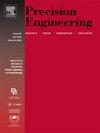基于超精密包络磨削的离轴非球面镜面斜率误差评价与预测模型
IF 3.7
2区 工程技术
Q2 ENGINEERING, MANUFACTURING
Precision Engineering-Journal of the International Societies for Precision Engineering and Nanotechnology
Pub Date : 2025-04-28
DOI:10.1016/j.precisioneng.2025.04.029
引用次数: 0
摘要
离轴非球面反射镜是聚焦光学系统的关键部件,其表面斜率误差会显著降低成像分辨率,因此需要精确控制。包络磨削是加工脆性材料光学反射镜的常用方法。为了研究坡度误差的形成机制,本研究开发了一种基于离散网格建模和迭代截面分层的地表轮廓预测算法。通过分析模拟曲面与理想曲面的矢状高度偏差来评估坡度误差。通过磨削实验,分析了等步长、等弧长和等高三种包络磨削路径策略下的坡度误差空间分布规律。实验结果表明,残差区域的细微差异导致了不同的空间误差分布。恒步进磨削的误差集中在中心附近,恒弧长磨削的误差分布在靠近中心的两侧,恒扇贝高度磨削的误差集中在外围边缘。通过实验观测,该算法达到了较高的预测精度。在相同参数下,恒步进磨削的坡度误差最小,均方根值为25.3 arcsec。这些发现为离轴非球面反射镜加工中的磨削路径优化和斜率误差减小提供了有价值的见解。本文章由计算机程序翻译,如有差异,请以英文原文为准。

Evaluation and prediction model of surface slope error for an off-axis aspheric mirror based on ultra-precision envelope grinding
Off-axis aspheric mirrors are critical components in focusing optical systems, where surface slope errors can significantly degrade imaging resolution, necessitating precise control. Envelope grinding is a common method for machining brittle-material optical mirrors. To investigate slope error formation mechanisms, this study developed a surface profile prediction algorithm based on discretized grid modeling and iterative cross-sectional layering. Slope errors were evaluated by analyzing sagittal height deviations between the simulated surface and ideal profiles. Grinding experiments were conducted to analyze the spatial distribution patterns of slope errors under three envelope grinding path strategies including constant step, constant arc-length, and constant scallop-height. Experimental results revealed that subtle differences in residual regions induced distinct spatial error distributions. Constant step grinding concentrated errors near the central region, constant arc-length grinding distributed errors bilaterally adjacent to the center, and constant scallop-height grinding localized errors at the peripheral edges. The algorithm achieved high prediction accuracy with experimental observations. Under identical parameters, constant step grinding achieved the smallest slope error with RMS value of 25.3 arcsec. These findings provide valuable insights for grinding path optimization and slope error mitigation in off-axis aspheric mirror manufacturing.
求助全文
通过发布文献求助,成功后即可免费获取论文全文。
去求助
来源期刊
CiteScore
7.40
自引率
5.60%
发文量
177
审稿时长
46 days
期刊介绍:
Precision Engineering - Journal of the International Societies for Precision Engineering and Nanotechnology is devoted to the multidisciplinary study and practice of high accuracy engineering, metrology, and manufacturing. The journal takes an integrated approach to all subjects related to research, design, manufacture, performance validation, and application of high precision machines, instruments, and components, including fundamental and applied research and development in manufacturing processes, fabrication technology, and advanced measurement science. The scope includes precision-engineered systems and supporting metrology over the full range of length scales, from atom-based nanotechnology and advanced lithographic technology to large-scale systems, including optical and radio telescopes and macrometrology.

 求助内容:
求助内容: 应助结果提醒方式:
应助结果提醒方式:


